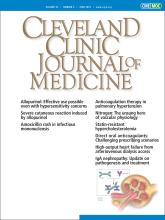ABSTRACT
Patients with COPD have an increased risk for severity of COVID-19. Flu-like symptoms with dyspnea may distinguish COVID-19 infection from dyspnea due to a COPD-related exacerbation. Management of COPD with COVID-19 warrants standard-of-care treatment with antimicrobial agents and corticosteroids, though limiting the dose and duration of steroids use may be warranted due to the risk of increased viral shedding. Modalities to treat acute respiratory failure can be used with some caveats. Patients with COPD and COVID-19 infection who treat their illness at home should self-isolate, use nebulizers in ways that avoid viral aerosolization, and frequently disinfect room surfaces.
COPD AND COVID-19
Chronic obstructive pulmonary disease (COPD) represents a large population of patients in the United States1 and is the fourth most common cause of death.2 Coexisting illnesses such as COPD increase the risk for severity of COVID-19,3,4 and a better understanding of the therapeutic implications for COVID-19 in the COPD population is needed.
Ways to distinguish early COVID-19-related viral dyspnea from a COPD exacerbation include the coexistence of flu-like symptoms not typically seen with COPD flare-ups, such as fever (89%),3 anorexia (40%), myalgia (35%), and gastrointestinal symptoms (40%).5
Steroids have been used with caution during COVID-19 infection given the increased viral shedding seen with the related coronaviruses MERS-CoV and SARS-CoV.6,7 There may be indications for treatment with steroids (such as in “cytokine storm”) in COVID-19 as these recommendations evolve.8 To date, no evidence of harm caused by the concurrent use of inhaled corticosteroids exists, and we recommend continuing these therapies for patients with COPD.
While previous coronaviruses have been associated with COPD exacerbations,9 MERS-CoV, SARS-CoV, and COVID-19 have not been shown to cause COPD exacerbations. If a patient presents with a COPD exacerbation with concurrent COVID-19 infection, we recommend standard-of-care treatment with corticosteroids,10 but at the same time trying to limit the dose and duration given the concern for increased viral shedding. Comorbid diabetes and hyperglycemia have also been associated with increased risk related to COVID-19,4,11 and glycemic control may be an additional challenge when using corticosteroids.
In addition to steroids, azithromycin is a common antimicrobial that is used for COPD exacerbations but has emerged as a possible adjunct therapy with hydroxychloroquine for COVID-19.12 As such, azithromycin may be in short supply. Alternative antimicrobial therapies may be used including clarithromycin, or second-or third-generation cephalosporins (eg, cefuroxime, cefpodoxime, cefinir) for those without risk factors for Pseudomonas infection. For those at risk of Pseudomonas infection, treatment with a fluoroquinolone (eg, ciprofloxacin, levofloxacin) may be considered.13
The usual standard of care for acute respiratory failure in COPD involves nebulized therapy, noninvasive positive pressure ventilation (NIPPV), and sometimes high-flow nasal cannula (HFNC) prior to committing to invasive mechanical ventilation. However, use of these modalities has the potential to cause aerosolization of COVID-19, thus increasing the risk of exposure of healthcare workers.14 We recommend continued use of these modalities with the following caveats:
Patients should be switched to bronchodilator therapy through metered-dose inhalers or dry-powder inhalers whenever possible. Metered dose inhalers should be utilized with a spacer.
When using nebulized therapy, HFNC, and NIPPV, healthcare workers in the room should wear personal protective equipment appropriate for airborne precautions. NIPPV use should include viral filters.
For HFNC, we recommend limiting the flow to less than 30 L/min.
While the threshold for endotracheal intubation and mechanical ventilation is considered lower for COVID-19, data from China4,6,15 show that HFNC and NIPPV were utilized often and that not all episodes of acute respiratory failure were severe enough to require mechanical ventilation. Therefore, we believe there is a role for these modalities and they must be weighed with the risk of COVID-19 aerosolization. While NIPPV use for acute respiratory distress syndrome (ARDS) is not considered standard of care,16 it is well recognized as an important aspect of treatment for acute respiratory failure secondary to COPD exacerbations and is associated with improvements in mortality rates.17
In terms of HFNC use in COPD, there are few studies that include use of HFNC in COPD patients with acute respiratory failure, thus further studies are needed. We believe that utilizing HFNC when a patient has hypercapnia (a common occurrence in COPD) should be avoided when possible because the data are limited or have failed to show benefit.16,18
COPD patients are particularly at risk for poor nutritional status19 and skeletal muscle loss, or sarcopenia.20 Those who develop ARDS from COVID-19 often require mechanical ventilation, and adjunct therapies for ARDS including neuromuscular blockade are both associated with intensive care unit-acquired weakness.21 Physical therapy and aggressive nutritional supplementation are extremely important to aid COPD patients in recovering from severe illness. The risk of prolonged mechanical ventilation in those with severe underlying COPD is high, and candid discussions with patients and families about difficulty weaning from ventilation and advanced-care planning should be performed early.
A significant proportion of COPD patients with COVID-19 will treat their illness at home. For patients who remain home, it is very important to self-isolate in a room and ideally have their own bathroom. Using a nebulizer in the home has the potential to aerosolize COVID-19. Viral particles can persistent in the air for 1 to 3 hours,22 The nebulizer should be used in a room with the doors closed and that remain closed for several hours afterwards. Also, cleaning and disinfecting surfaces in the room should be done often. Patients with COPD can consider increasing their bronchodilator use with nebulizers or inhalers while infected with COVID-19 but should only do so after discussion with their provider.
Footnotes
The statements and opinions expressed in COVID-19 Curbside Consults are based on experience and the available literature as of the date posted. While we try to regularly update this content, any offered recommendations cannot be substituted for the clinical judgment of clinicians caring for individual patients.
- Copyright © 2020 The Cleveland Clinic Foundation. All Rights Reserved.






